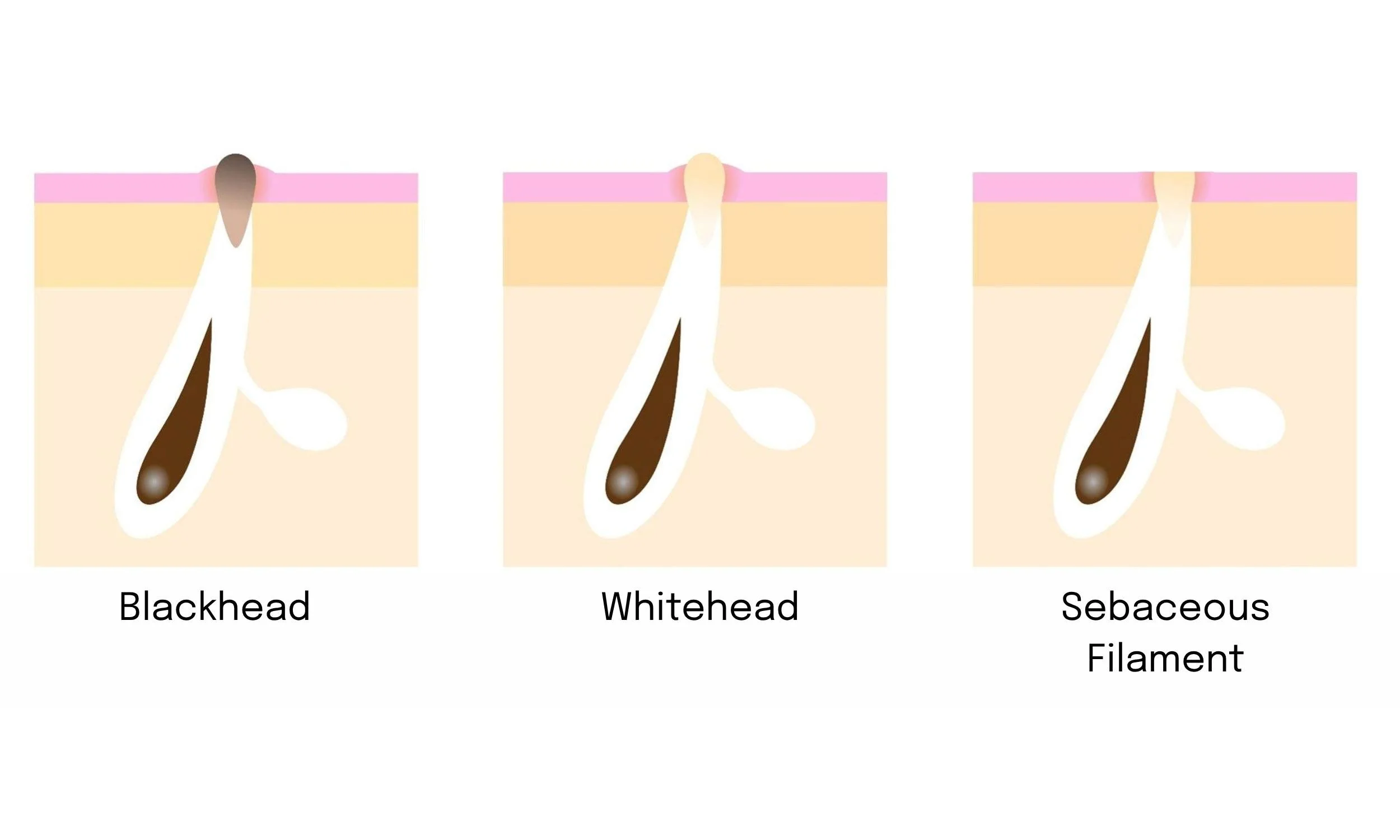🧪The Real Reason You Still Have Blackheads (Even With Actives)
This post contains affiliate links. As an Amazon Associate, I earn from qualifying purchases—at no extra cost to you. I only recommend products I truly believe in.
Let’s Get Real: You’re Doing “All the Right Things”
You’re exfoliating. You’re masking. You’ve got a salicylic acid serum, a clay mask you only use on Wednesdays, and even that one toner your cousin swears by. So why—why—are those little black dots still hanging out on your nose like it’s their full-time job?
First of all: you’re not doing anything wrong. Blackheads are stubborn little suckers, and most of us have them—especially in oilier zones like the nose, chin, and cheeks. But here’s the plot twist no one tells you: sometimes, even the “right” skincare steps don’t get to the real problem.
This post is your no-BS guide to what’s actually behind persistent blackheads (even if you’ve got a shelf full of actives). We’re breaking down the sneaky reasons your pores are still clogged, what science says about sebaceous filaments, and what really works—without nuking your skin barrier.
Let’s go pore-deep. 🫠
What Blackheads Actually Are (And What They’re Not)
Let’s clear something up—literally. Not every dark speck on your nose is a blackhead.
In fact, most of what you think are blackheads might actually be sebaceous filaments. And treating the two like they’re the same? That’s where things go sideways.
Blackheads are open comedones—tiny hair follicles clogged with dead skin and oil that’s been exposed to air and oxidized. They’re usually raised, stubborn, and take their sweet time to leave.
Sebaceous filaments, on the other hand, are your skin’s built-in oil transport system. They’re supposed to be there. They sit flatter, look more uniform, and come back no matter how many acids or masks you throw at them.
Think of it like this:
Blackheads = unwanted guests.
Sebaceous filaments = annoying roommates who actually pay rent.
The problem? A lot of skincare advice lumps them together. That’s how we end up scrubbing, peeling, and vacuuming our skin into submission—only to still see dots in the mirror.
Knowing the difference is step one. Step two? Treating the actual issue instead of going full exorcism on your pores.
The Real Culprits: 5 Reasons Blackheads Stick Around
You’ve got your BHA. You’re double cleansing. You even resist the urge to pick (most of the time). So what gives?
Here are the five science-backed reasons your blackheads are still holding the line—even with actives in play:
1. You’re Over-Exfoliating
More exfoliation ≠ better results. When you go too hard with acids or scrubs, you can damage your skin barrier—and that kicks off a vicious cycle.
A compromised barrier = more oil, more buildup, and ironically... more clogged pores.
Sometimes the issue isn’t that your products aren’t strong enough—it’s that your skin is too irritated to benefit from them.
2. Your Actives Aren’t Penetrating Deep Enough
Not all exfoliants are created equal. Some (like glycolic acid) work on the surface, while others (like salicylic acid) go deep into pores. If you’re using the wrong one—or it’s in the wrong pH or formula—it might never reach the gunk you’re trying to break down.
Actives only work if they can actually get where they’re needed.
3. You’re Skipping Hydration
Dehydrated skin can lead to thicker, stickier sebum that’s more likely to clog pores. It also slows your skin’s natural exfoliation cycle, leaving dead skin cells hanging around longer than they should.
The fix? Layer in hydrating ingredients like hyaluronic acid and glycerin, and don’t skip your moisturizer—yes, even if you’re oily.
4. You’re Messing With Your Skin’s Oil Balance
Think skipping moisturizer or using harsh cleansers will “dry up” your blackheads? Think again.
When your skin feels stripped, it goes into panic mode and produces more oil to compensate. That excess oil can mix with dead skin and clog things right back up.
Balanced skin = happy pores.
5. You’re Using the Wrong Actives for Your Skin Type
Not every active works the same for every skin type. For example, glycolic acid (an AHA) is great for surface glow but doesn’t do much inside your pores. Salicylic acid (a BHA), on the other hand, is oil-soluble and dives deep.
Some skin types respond better to gentler actives like PHAs, or need a combo of actives to see results—like salicylic acid paired with a retinoid.
What Does Help (Backed by Science)
Let’s skip the gimmicks and get into what actually clears blackheads—without wrecking your barrier or your patience. These ingredients have legit research behind them, and they’ve earned their spot in your skincare lineup:
Salicylic Acid (BHA)
This is your MVP. Salicylic acid is oil-soluble, which means it can slide right into your pores and break up the gunk from the inside.
Use it in a cleanser for mild maintenance, or a leave-on treatment for deeper exfoliation.
Try: Paula’s Choice 2% BHA Liquid Exfoliant
👉 Check price on Amazon
Retinoids
These vitamin A derivatives speed up cell turnover, keep dead skin from piling up, and help prevent future clogs. They’re also backed by decades of research on acne and comedones.
Try: Differin Gel (Adapalene 0.1%)
👉 Check price on Amazon
Or if you’re ready to level up: Paula’s Choice 1% Retinol Treatment
👉 Check price on Amazon
Niacinamide
This oil-balancing all-star helps regulate sebum production, strengthens your skin barrier, and plays nicely with both BHAs and retinoids. It’s one of the best non-irritating ingredients for blackhead-prone skin.
Try: The Ordinary Niacinamide 10% + Zinc 1%
👉 Check price on Amazon
Or upgrade to a smoother texture: Naturium Niacinamide Serum 12% + Zinc 2%
👉 Check price on Amazon
Clay Masks
Clay absorbs excess oil and can help reduce the appearance of clogged pores. But the key is using it in moderation—think 1–2x per week max.
Try: Innisfree Volcanic Clay Mask
👉 Check price on Amazon
Gentle Cleansers with Actives
A cleanser with salicylic acid can help you maintain clear pores—without overdoing it.
Try: CeraVe Renewing SA Cleanser
👉 Check price on Amazon
What Doesn’t Help (Sorry, TikTok)
Let’s lovingly escort some of these overhyped fixes to the skincare graveyard. If you’ve tried these and your blackheads are still thriving, you’re not alone—because the science doesn’t back them up.
Pore Strips
Sure, it’s satisfying. But those little forest strips you pull out? Mostly sebaceous filaments—not blackheads. And the adhesive can actually irritate your skin, making oil production worse.
It’s like pulling weeds without getting the roots. They’ll be back in a week… angrier.
Harsh Scrubs
If your exfoliator feels like sandpaper, put it down.
Scrubs with large, jagged particles (like walnut shells) can create microtears in your skin. They don’t clear your pores—they just make your face mad. And inflammation? It’s blackhead fertilizer.
DIY Toothpaste or Lemon “Masks”
Nope. Just no. These mess with your skin’s pH and can cause serious irritation.
Toothpaste is for teeth. Lemons are for cocktails. Let’s not burn our faces in the name of experimentation.
Over-Cleansing
Washing your face four times a day won’t wash the blackheads away.
Too much cleansing strips your skin, damages your barrier, and leads to rebound oiliness. That oil? It’s coming back with a vengeance—and bringing blackheads along for the ride.
Thinking You Can “Close” Pores
Pores aren’t doors. They don’t open and close.
You can reduce their appearance by keeping them clean and minimizing inflammation, but anyone promising to “close” them for good is selling snake oil in cute packaging.
The Final Takeaway (and What to Do Next)
Here’s the truth: blackheads aren’t a sign that your skincare routine sucks. They’re just stubborn. And treating them isn’t about nuking your face with the strongest acid you can find—it’s about strategy, consistency, and knowing what actually works.
🧪 Use actives that actually penetrate pores (hi, salicylic acid).
🧼 Keep your skin balanced—not stripped.
🙅♀️ Ditch the gimmicks (looking at you, lemon juice).
💧Don’t forget to hydrate. Oily ≠ moisturized.
Blackheads don’t vanish overnight—but with the right combo of ingredients and habits, you’ll start seeing smoother, clearer skin that stays that way.
Want to dig deeper?
If tools tempt you, know what they can and can’t do. Evidence on pore vacuums, LED, and microneedling.
Masking can help with oil and debris—within limits. What clay masks can (and can’t) do for pores.
Want the shopping list version? Best AHAs & BHAs for large pores (with product picks).
📚 References
Dreno B, Araviiskaia E, Berardesca E, et al. Microbiome in healthy skin, update for dermatologists. J Eur Acad Dermatol Venereol. 2016;30(12):2038–2047.
Tanghetti EA. The role of inflammation in the pathology of acne. J Clin Aesthet Dermatol. 2013;6(9):27–35.
Bowe WP, Patel NB, Logan AC. Acne vulgaris, probiotics and the gut-brain-skin axis – back to the future? Gut Pathog. 2011;3(1):1.
Kim J, Kim BE, Leung DYM. Pathophysiology of atopic dermatitis: clinical implications. Allergy Asthma Proc. 2019;40(2):84–92.
Kircik LH. The role of topical retinoids in the treatment of acne. J Drugs Dermatol. 2005;4(4):459–464.
Zouboulis CC, et al. Retinoids in the treatment of acne: their mechanisms of action and safety profile. J Eur Acad Dermatol Venereol. 2001;15(Suppl 3):5–12.
Mukherjee S, Date A, Patravale V, et al. Retinoids in the treatment of skin aging: an overview of clinical efficacy and safety. Clin Interv Aging. 2006;1(4):327–348.
Draelos ZD. The effect of 0.1% adapalene gel on acne vulgaris and facial skin condition. Cutis. 2005;76(2 Suppl):6–13.
Draelos ZD. Niacinamide—an update on skin benefits. Cutis. 2019;104(3):E21–E24.
Bowe WP, Shalita AR. Effective over-the-counter acne treatments. Semin Cutan Med Surg. 2008;27(3):170–176.
Draelos ZD. The multifunctional role of niacinamide in dermatology. Skin Pharmacol Physiol. 2019;32(2):87–93.
Sugiyama-Nakagiri Y, Naoe A, Ohuchi A, et al. Functional characterization of sebum free fatty acids in epidermal barrier and inflammation: impact on acne pathogenesis. J Dermatol Sci. 2015;79(2):152–159.
Mazzarello V, Dore MP, Scanu AM, et al. A randomized split-face clinical trial to evaluate the effectiveness of a clay mask in treating acne vulgaris. Clin Cosmet Investig Dermatol. 2018;11:491–497.
Mahmood T, Akhtar N, Khan BA. The morphology, biology, and treatment of acne. Clin Cosmet Investig Dermatol. 2011;4:41–47.



